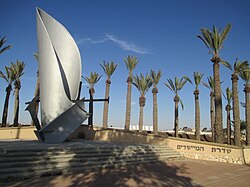Dimona
Dimona
|
||
|---|---|---|
| Hebrew transcription(s) | ||
| • ISO 259 | Dimona | |

Tumarkin sculpture at entrance to Dimona
|
||
|
||
| Coordinates: 31°4′N 35°2′E / 31.067°N 35.033°ECoordinates: 31°4′N 35°2′E / 31.067°N 35.033°E | ||
| District | Southern | |
| Founded | 1955 | |
| Government | ||
| • Type | City | |
| • Mayor | Beni Bitton | |
| Area | ||
| • Total | 29,877 dunams (29.877 km2 or 11.536 sq mi) | |
| Population (2015) | ||
| • Total | 33,258 | |
Dimona (Hebrew: דִּימוֹנָה) is an Israeli city in the Negev desert, 36 kilometres (22 mi) to the south of Beersheba and 35 kilometres (22 mi) west of the Dead Sea above the Arava valley in the Southern District of Israel. In 2015 its population was 33,258.
The city's name is derived from a biblical town, mentioned in Joshua 15:21-22.
Dimona was one of the development towns created in the 1950s under the leadership of Israel's first Prime Minister, David Ben-Gurion. Dimona itself was conceived in 1953, and settled in 1955, mostly by new immigrants from Northern Africa, who also constructed the city's houses. The emblem of Dimona (as a local council), adopted 2 March 1961, appeared on a stamp issued on 24 March 1965.
When the Israeli nuclear program started later that decade, a location not far from the city was chosen for the Negev Nuclear Research Center due to its relative isolation in the desert and availability of housing.
In spite of a gradual decrease during the 1980s, the city's population began to grow once again with the beginning of the Russian immigration in the 1990s. Currently, Dimona is the third largest city in the Negev, with the population of 33,900. Due to projected rapid population growth in the Negev, the city is expected to triple in size by 2025.
Dimona is described as "mini-India" by many for its 7,500-strong Indian Jewish community. It is also home to Israel's Black Hebrew community, formerly governed by its founder and spiritual leader, Ben Ammi Ben-Israel, now deceased. The Black Hebrews number about 3,000 in Dimona, with additional families in Arad, Mitzpe Ramon and the Tiberias area. Their official status in Israel was an ongoing issue for many years, but in May 1990, the issue was resolved with the issuing of first B/1 visas, and a year later, issuing of temporary residency. Status was extended to August 2003, when the Israeli Ministry of Interior granted permanent residency.
...
Wikipedia


